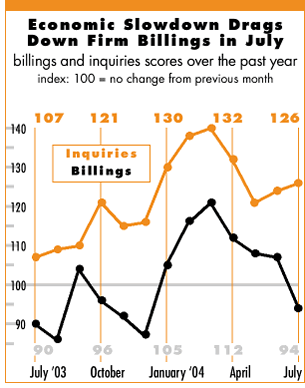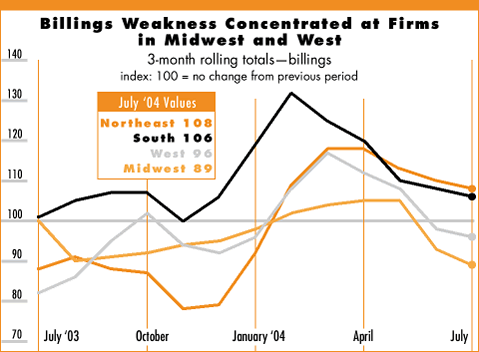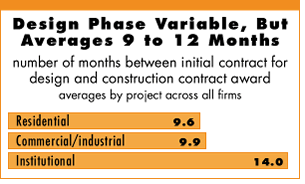

Soft Spot in Economy
Reflected in July Billings
Design phase averages nine months; more
for institutional projects

by Kermit Baker,
PhD, Hon. AIA
Chief Economist
 In
July, architecture firms felt the effects of a (hopefully) brief slowdown
in the economy. After a strong first half of the year, the second half
began on a down note as more firms reported a decline in billings than
reported an increase. Despite a retrenchment in monthly business activity,
firms reported strong gains in inquiries for new projects.
In
July, architecture firms felt the effects of a (hopefully) brief slowdown
in the economy. After a strong first half of the year, the second half
began on a down note as more firms reported a decline in billings than
reported an increase. Despite a retrenchment in monthly business activity,
firms reported strong gains in inquiries for new projects.
Firms concentrating in the residential sector reported continued strength in billings, while those with a majority of their activity in the commercial/industrial or institutional sectors were more likely to report declining billings. Firms of all concentrations uniformly reported strong inquiries for new work.
Regional business conditions were quite uniform through the first half of the year. Recently, they are beginning to diverge. Firms in the Midwest reported a sharp drop in billings in July, while firms in the West reported a mild downturn. Firms in the Northeast and South saw growth in billings ease a bit, but still remained positive.
Broader economy has
slowed
The broader economy has slipped over the past two months, with employment
growth being the most obvious sign of a slowdown. Business payrolls increased
by an average of only 55,000 net new positions per month nationally in
June and July, after averaging 225,000 per month through the first five
months of the year. Construction payrolls unfortunately have followed
this trend, increasing by only 3,500 per month over the past two months
as compared to 27,000 on average over the first five.

While employment growth has been slowing, inflation has been accelerating. Consumer prices have risen more than 3 percent over the past year, while wholesale prices have climbed 4 percent. Much of this gain is from more volatile food and fuel prices. Construction materials have felt the pinch of rising prices. Iron and steel scrap prices, which often are used as benchmarks for broader steel pricing, shot up in July and have doubled over the past year.
All this volatility in the economy is adding to consumer and business nervousness. Business confidence fell in the second quarter according to the Conference Board’s CEO Business Confidence Survey, and consumer sentiment fell with the preliminary August reading, according to the University of Michigan survey. The Federal Reserve Board feels the weakness is temporary. By raising short-term interest rates a quarter point at their mid-August meeting, they signaled that inflation generated by strong growth overshadows an economic slowdown on their list of concerns.
Design phases show
considerable variation
Even with mounting pressures to compress the construction phase of projects,
the design phase often extends for 9 to 12 months. Firms were asked for
the typical length of time between when architects begin work on a project,
and when the construction contract is awarded. Firms report that the design
period for residential projects averages over 9 months, almost 10 months
for commercial/industrial projects, and 14 months for institutional projects.
 As
you might expect, there is considerable variation around these averages.
For about 40 percent of residential as well as commercial/industrial projects,
the design phase lasts under six months, although for about a quarter
of projects in these building types, the design phase lasts over a year.
Only about 20 percent of institutional projects are designed in six months
or less, although close to half (47.6 percent) extend a year or longer.
As
you might expect, there is considerable variation around these averages.
For about 40 percent of residential as well as commercial/industrial projects,
the design phase lasts under six months, although for about a quarter
of projects in these building types, the design phase lasts over a year.
Only about 20 percent of institutional projects are designed in six months
or less, although close to half (47.6 percent) extend a year or longer.
Other than project size and complexity, firms report three major factors influencing the design time. Client decision making was frequently mentioned as a factor, and whether these decisions need single or multiple approvals. Financing and funding for the project often influenced the design period. Finally, regulatory approvals—land entitlement, special use permits, zoning, environmental issues, and historical considerations—were frequently mentioned as influencing the length phase of projects.
Copyright 2004 The American Institute of Architects.
All rights reserved. Home Page ![]()
![]()
 |
||
| This month, Work-on-the-Boards survey participants are saying: • Work is taking longer to get under contract and released
after contract. • Flat market for commercial projects, and public sector
work is between funding cycles so new opportunities are not available. • Getting a lot of calls from contractors looking for winter
projects. They have work now but are looking for future work. • Generally improving picture; substantially more inquiries
in July than in previous months.
|
||